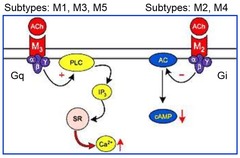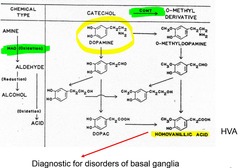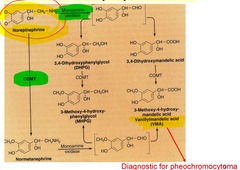Neurotransmission & Neurochemistry – Flashcards
Unlock all answers in this set
Unlock answersquestion
What is a synapse?
answer
specialized junctions where neuronal axons contact another neuron or cell type
question
Type I synapse
answer
-excitatory -axodendritic -round presynaptic vesicles -presynaptic specialization -large active zone -wide cleft -large postsynaptic density
question
Type II synapse
answer
-inhibitory -axoaxonic -flat presynaptic vesicles -few presynaptic specializations -small active zone -narrow cleft -non-uniform postsynaptic density
question
SNARE proteins
answer
expressed in membranes of neurotransmitter vesicles and axon terminals; facilitate docking
question
synaptotagmine
answer
Ca2+ sensor protein in membrane of neurotransmitter vesicles
question
synaptobrevin
answer
allows neurotransmitter vesicle to bind with cell membrane; interacts with syntaxin & SNAP-25
question
G-alpha-s subunit
answer
activates adenylyl cyclase--> more cAMP--> more active PKA
question
G-alpha-i/o subunit
answer
inhibits adenylyl cyclase--> less cAMP--> less PKA
question
G-alpha-q subunit
answer
stimulates phospholipase C-beta--> breaks PIP2 into IP3 + DAG
question
4 characteristics to be a neurotransmitter
answer
1. Produced & stored in vesicles in presynaptic neuron 2. Released in response to presynaptic depolarization; Ca-dependent 3. High-affinity receptors on post-synaptic cell 4. Mechanism to terminate activation
question
3 mechanisms to terminate neurotransmitter action
answer
1. Diffusion away from receptor 2. Enzymatic degradation 3. Re-uptake
question
choline acetyltransferase (ChAT)
answer
synthesizes acetylcholine from choline + acetyl CoA in presynaptic cell
question
vesicular acetylcholine transporter
answer
transports ACh into vesicle for storage in presynaptic cell
question
acetylcholine esterase (AChE)
answer
hydrolyzes acetylcholine--> choline + acetic acid *FASTEST enzyme in the body!
question
choline transporter
answer
brings choline back into presynaptic cell so it can be used for synthesis of ACh
question
agonists of muscarinic receptors
answer
acetylcholine, muscarine
question
subtypes of muscarinic receptors

answer
*M1, M3, M5--> Gq --> PLC--> more Ca *M2, M4--> Gi--> inhibit adenylyl cyclase
question
agonists of nicotinic receptors
answer
acetylcholine, nicotine
question
alpha-bungarotoxin
answer
irreversibly binds & inhibits (competitive antagonist) activation of muscle nicotinic ACh receptors & alpha-7 nicotinic ACh receptors
question
curare
answer
inhibits ALL nicotinic ACh receptors (competitive antagonist)
question
nicotinic receptors
answer
ionotropic: non-selective cation channels 5 subunits, doughnut shape 2nd transmembrane domain of each subunit lines ion channel agonist binds N-terminal domain of alpha subunit
question
What is the end plate potential (EPP)?
answer
Depolarization of skeletal muscle fibers caused by neurotrasmitters binding to post-synaptic receptors -always a multiple of mEPPs--> need MULTIPLE vesicles to release NT
question
What is the miniature end plate potential (mEPP)?
answer
Depolarization of a skeletal muscle fiber resulting from the ACh released from ONE vesicle - happens spontaneously, even when there's no AP in pre-synaptic neuron
question
Myasthenia gravis
answer
Organ-specific autoimmune disorder Usually auto-antibodies against muscle nAChRs Sometimes antibodies against MusK (stabilizes nAChR expression at NM junction) -muscle weakness starts at eyes--> moves down -gets worse with activity
question
Pyridostigmine
answer
Reversible inhibitor of acetylcholinesterase--> increases lifetime of ACh in synaptic cleft Treat myasthenia gravis
question
Lambert-Easton Myasthenic Syndrome (LEMS)
answer
Auto-antibodies against Ca channels in pre-synaptic motor neurons -muscle weakness starts at extremities--> moves up -gets better with activity
question
Organophosphorus pesticide poisoning: Cholinergic crisis
answer
irreversible inhibition of acetylcholinesterase--> over-stimulation of muscarinic & nicotinic receptors Muscarinic syndrome: miosis (pupil contriction), profuse secretions, bradycardia, bronchoconstriction, hypotension, diarrhea Nicotinic syndrome: tachycardia, muscle weakness CNS: anxiety, confusion, tremors, seizures, cardiorespiratory paralysis
question
What is the important structural difference between nAChR subunits and ionotropic glutamate subunits?
answer
nAChR subunits each have 4 transmembrane domains vs Ionotropic glutamate receptor subunits: 2nd "transmembrane" domain loops back inside, doesn't actually cross the cytoplasmic membrane
question
3 functional classes of ionotropic glutamate receptors
answer
NMDA AMPA Kainate *All have 5 subunits, non-selective cation channels
question
What is the major mechanism for terminating the action of GLUTAMATE in the synaptic cleft?
answer
Glial cells take up GLUTAMATE--> Glutamine synthase makes GLUTAMINE--> releases back to pre-synaptic cells
question
How do Class II metabotropic glutamate receptors (mGluR2 & 3) lead to inhibition of the post-synaptic cell?
answer
These receptors are coupled to a Gi alpha subunit: bind Glu-->reduce adenylyl cyclase activity-->reduce PKA activity--> INCREASE K channel activity--> K flows out of cell--> HYPERPOLARIZATION = inhibition
question
How do Class I metabotropic glutamate receptors (mGluR1 & 5) lead to plasticity in the post-synaptic cell?
answer
These receptors are coupled to Gq alpha subunits: bind Glu-->activate PLC-->increase DAG & IP3-->increase PKC & [Ca]-->modify translation and transcription = PLASTICITY
question
How can metabotropic glutamate receptors lead to pre-synaptic inhibition of glutamate release?
answer
These receptors are bound to Gi alpha subunits: bind Glu-->inhibit adenylyl cyclase-->inhibit Ca influx via Ca channels-->prevent depolarization = INHIBITION
question
What determines the calcium permeability of AMPA receptors?
answer
RNA editing of the GluR2 subunit: if arginine gets substituted for glutamine at a certain position, the channel will be IMPERMEABLE to Ca
question
What makes NMDA unique among ALL neurotransmitter receptors?
answer
To be activated, it requires simultaneous binding of: -primary agonist (glutamate, aspartate, or NMDA) -co-agonist (glycine, serine)
question
What is the role of MAGNESIUM in NMDA receptor signaling?
answer
Extracellular concentration exerts a voltage-dependent block of the channel
question
How is the Mg block of NMDA receptors removed?
answer
Membrane depolarization; usually accomplished by activation of AMPA receptors
question
Kynurenic acid
answer
competitive antagonist at the glycine site on NMDA receptors
question
Non-competitive antagonists of NMDA receptors
answer
1. PCP (phencyclidine, drug of addiction) 2. Ketamine (anesthetic) 3. Ifenprodil 4. Memantine (Alzheimer's) 5. Lead (Pb2+)
question
How do extrasynaptic NMDA receptors differ from synaptic NMDA receptors?

answer
Synaptic--> turn on CREB pathways--> cell survival--> plasticity Extrasynaptic--> shut off CREB pathways--> cell death
question
Memantine
answer
Non-competitive antagonist of EXTRASYNAPTIC NMDA receptors; prevent neuronal death in late-stage Alzheimer's *NOT for early disease b/c also blocks nicotinic receptors
question
What are the 2 ways that GABA is re-uptaken from the synaptic cleft?
answer
1. Re-uptake by pre-synaptic neuron 2. Re-uptake by glial cells--> convert to Gln--> release back to pre-synaptic neuron
question
Type of cell where GABA trasmission is mostly used
answer
Interneurons-- control activity of excitatory pathways in the brain
question
Barbiturates
answer
Increase the DURATION of GABA-induced channel activation--> inhibition of other neurons *Anti-convulsant
question
Benzodiazepines
answer
increase the FREQUENCY of GABA-induced channel activation--> inhibition of other neurons *Anti-convulsant
question
Antagonists of GABA receptors
answer
Cause convulsions by relieving inhibition of excitatory neurons - Bicuculline - Picrotoxin - Dieldrin (organochlorine pesticide)
question
Ionotropic GABA receptors
answer
GABA- A and C (C is only expressed in retina) Permeable to Cl- Just like nicotinic ACh receptors: 5 subunits with 4 transmembrane domains each, 2nd domain lines channel
question
When is GABA signaling excitatory instead of inhibitory?
answer
Developing brain: predominant expression of NKCC1--> high resting intracellular [Cl-]
question
Why is GABA signaling inhibitory in the adult brain?
answer
KCC2 expression prevails over NKCC1--> low resting intracellular [Cl-]--> GABA stimulation makes Cl- flow in--> hyperpolarization
question
Metabotropic GABA receptors
answer
GABA-B Coupled to Gi proteins--> inhibits adenylyl cyclase Beta-gamma dimer inactivates voltage-gated Ca channels, activates voltage-gated K channels
question
Baclofen
answer
Agonist of GABA-B receptors Treat muscle spasms
question
Major inhibitory neurotransmitter in the spinal cord
answer
Glycine
question
Inhibitory interneurons in spinal cord, feedback inhibition loop with motor neurons; use glycine as neurotransmitter
answer
Renshaw cells
question
Serine hydroxymethyltransferase
answer
Serine-->Glycine in presynaptic terminal Needs folate as co-factor
question
Hyperekplexia
answer
Exaggerated startle response to acoustic & tactile stimuli Caused by mutation in glycine receptor alpha subunit
question
Glycine receptors
answer
Ionotropic ONLY Permeable to Cl-
question
Strychnine
answer
Inhibits glycine receptors--> excessive muscle contraction Rat poison
question
4 steps in catecholamine synthesis
answer
1. Hydroxylation: tyrosine--> DOPA 2. Decarboxylation--> dopamine 3. Hydroxylation--> norepinephrine 4. Methylation--> epinephrine
question
What is the rate-limiting step in catecholamine synthesis?
answer
Tyrosine hydroxylase: tyrosine--> DOPA
question
4 co-factors for tyrosine hydroxylase
answer
1. Fe2+ 2. Oxygen 3. Biopterin 4. NADPH
question
2 ways to increase activity of tyrosine hydroxylase
answer
1. Phosphorylation of TH; mediated by increased intracellular cAMP 2. Phosphorylation of CREB (long-term, only after prolonged neuronal activation)
question
2 feedback inhibitors of tyrosine hydroxylase
answer
Norepinephrine Dopamine (via autoreceptors)
question
Only enzyme in catecholamine synthesis that's located inside the NT vesicle
answer
Dopamine beta-hydroxylase (dopamine-->NE)
question
PNMT enzyme is expressed mostly in what tissue?
answer
Adrenal chromaffin granules (NE-->epi) A few neurons also do this
question
Controls uptake of monoamines into synaptic vesicles
answer
VNMTs (vesicular monoamine transporters)
question
Primary breakdown product of dopamine; low levels in CSF are diagnostic of___

answer
Homovanillic acid (HVA) Disorders of the basal ganglia
question
2 enzymes involved in breakdown of catecholamines
answer
Monoamine oxidase (MAO) Catecholamine-O-Methyl transferase (COMPT)
question
Primary breakdown product of norepinephrine; high levels in blood are diagnostic for ___

answer
Vanillylmandelic acid (VMA) Pheochromocytoma
question
Major means of terminating dopamine synaptic activity
answer
Reuptake into presynaptic cells by dopamine transporters
question
4 similarities between catecholamine and serotonin synthesis
answer
1. Dietary source 2. Hydroxylated by rate-limiting enzyme 3. Decarboxylated by AAD 4. Degraded by oxidation by MAO
question
Driving force for NT reuptake via SLC6 transporters
answer
Na (co-transport) or K (counter-transport) gradient
question
Alpha adrenergic receptors
answer
Excitatory Increase calcium or reduce cAMP
question
Beta adrenergic receptors
answer
Inhibitory Increase cAMP
question
D1 receptors
answer
for dopamine increase cAMP not autoreceptors
question
D2 receptors
answer
for dopamine decrease cAMP can be autoreceptors targets for antipsychotics
question
2 norepinephrine pathways in the brain
answer
1. locus coeruleus--> cortex reticular formation--> NTS 2. spinal cord
question
2 dopaminergic pathways in the brain
answer
1. Nigrostriatal (substantia nigra--> striatum) 2. Mesolimbic (VTA--> frontal cortex & nucleus accumbens)
question
serotonergic pathways in the brain
answer
more diffuse that catecholaminergic pathways cell bodies in Raphe nuclei--> project to multiple areas throughout brain *Sleep, wakefulness, mood
question
Regulation of neuropeptide expression is largely ______.
answer
transcriptional (transcription factors, e.g. CREB, bind to response elements, turn transcription on/off)



